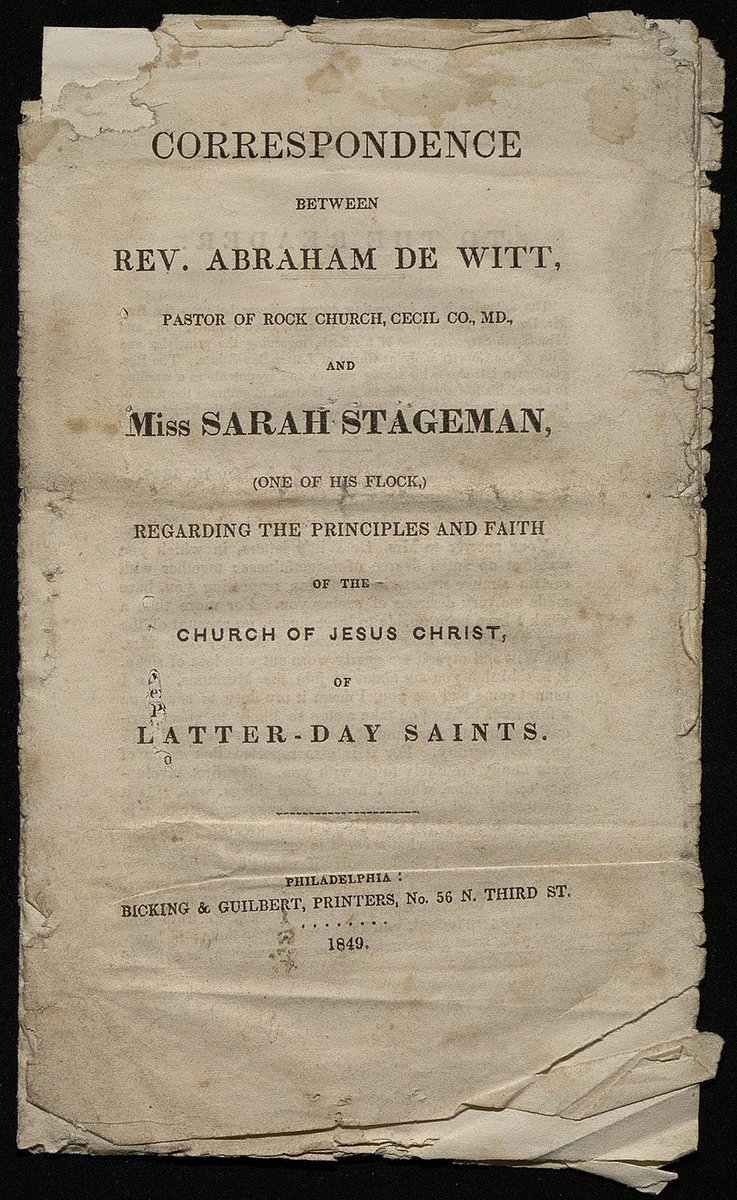The Anti-Mormon Pamphlet That Wasn’t
This story of Sarah Stageman–her conversion, her conviction, and her pamphlet–provides a compelling example of how each person can think clearly, value fairness, and quench bad information (pages 157-158).

Recently, the acquisitions team in the Church History Library encountered a pamphlet that was not part of our collection. It was understood to be an anti-Mormon pamphlet from 1849, but as we studied its text and placed it into historical context, we discovered that the pamphlet had been gravely misunderstood.
The pamphlet opens with a caustic letter by Rev. Abraham De Witt, the Princeton-educated pastor of Rock Presbyterian Church in Cecil County, Maryland. He condescendingly chastises a young girl for even considering the Church, declaring that she has an “excitable and unstable mind” and warning her to “escape as for your life from this vortex of fanaticism.”
This is clearly an anti-Mormon letter and for this reason the pamphlet was considered an anti-Mormon publication. Accordingly, it was not included in Peter Crawley’s descriptive bibliography or in the original print version of Flake and Draper’s Mormon bibliography. Copies of the pamphlet in other library collections are cataloged with De Witt as its author.
But the pamphlet was not assembled by Rev. De Witt. His letter is presented first so that the girl he attacked could rhetorically demolish it.
Sarah Stageman had been born in England in 1826. When she was 14 years old, she had immigrated to Maryland with her parents and four younger siblings. While in her early twenties, she met and listened to Latter-day Saint missionaries. In her excitement, she consulted with Anna De Witt, who obviously informed her pastor husband. Rev. De Witt poured his scorn into a critical letter that he asked Sarah to share with her family and friends. He followed his own advice by repeating his written message in whispers to his flock. Sarah followed his counsel by publishing his folly.
Sarah begins by pointing out that De Witt had not cited any scripture in his 3 ½ page letter. Accordingly, her 8 ½ page response is a virtual tour de force of the Bible that cites more than 40 passages to testify of the truth of the Restoration, the last days, visions and revelations, Joseph Smith as a true prophet, the apostasy, the gathering of Israel, gospel dispensations, the restoration of priesthood authority, and the workings of God in His own way.
When asked by De Witt how she “made the discovery that Mr. and Mrs. De Witt, and the members of Rock Church and of other Churches, have no religion,” Sarah admits that it came with no help from him. “You inquire of me, if I have clearer views of my need of the ‘Holy Spirit.’ I answer, yes! But, was I confirmed by you, in the laying on of hands, to receive the gift of the Holy Spirit;–as was done by the Apostles”?
Sarah likewise had a ready answer for De Witt’s criticism of Joseph Smith. “You say if Joseph Smith was inspired, why did he locate that temple where it would be begun, but never finished: If he had, you would believe. But the Lord works in his own way. There is a city in Ezekiel we do not read of being built.” She pegged De Witt as like unto the unbelievers of an earlier scriptural age: “I say thus it is now, as it was in the days of Christ. In Mark, Chap. 15, ‘They said, let the king of Israel descend from the Cross, that we may see and believe.’”
No, this is definitely not an anti-Mormon pamphlet. Rather, it is a record of the significance of conversion in the life of a young woman newly converted to the restored gospel of Jesus Christ. Its recovery from misunderstanding exemplifies of one of the ways we might re-engage historical sources to see the significance of conversion in the study of Mormon history.
Citation:
Correspondence between Rev. Abraham De Witt, pastor of Rock Church, Cecil Co., Md. and Miss Sarah Stageman, one of his flock, regarding the principles and faith of the Church of Jesus Christ of Latter-day Saints (Philadelphia: Bicking & Guilbert, Printers, 1849).
- Read the full pamphlet here (digitized in the Church History Catalog).
- See information about the pamphlet in the Church History Catalog.
- Browse other items in the Church History Library by and about Sarah Stageman.
[Note: This discovery and its story were shared as part of a talk I gave at the Church History Symposium.]



[…] The Anti-Mormon Pamphlet That Wasn’t […]